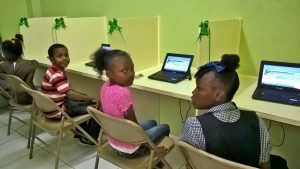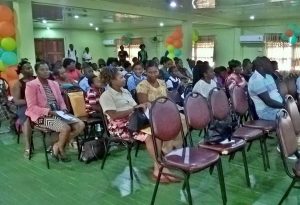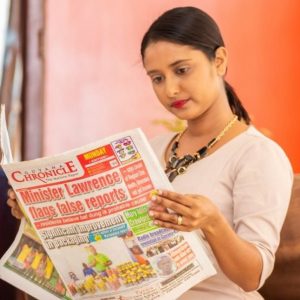-in bid to help residents become computer-literate
THE government on Wednesday officially declared open an Information Communications Technology (ICT) Hub in Albouystown, thereby making 14 Internet-ready computers available to residents there free of cost.

The Government of Guyana has indicated that it is not content with simply providing Guyanese with devices to help them access government services via the Internet, but wants to simultaneously provide the connectivity and training that are necessary.
That’s according to Director of the National Data Management Authority (NDMA), Mr. Phillip Walcott, who made the observation during the opening of the facility.
The community hub, which is located in the compound of the Heavenly Light Church on Cooper Street, will be open to the public from 16:00hrs to 21:00hrs daily.
A total of four such community hubs were promised to Constituency 10, with Albouystown awaiting one more, and the other two going to the Charlestown community.
Walcott said the hub is in keeping with President David Granger’s vision for all Guyanese, even those in poor and remote communities, to become computer literate.
The vision of the NDMA, an agency which falls under the Ministry of Public Telecommunications’ E-Government Department, is to establish a total of 426 community hubs countrywide over a period of five years, and the authorities are currently in the process of connecting 120.
In its bid to bridge the digital divide between the hinterland region and the coastland, the government proposes to establish 212 of those facilities in Regions One (Barima-Waini), Seven (Cuyuni-Mazaruni), Eight (Potaro-Siparuni) and Nine (Upper Takutu-Upper Essequibo), while the other 214 will be created along the coast.
MATTER OF AFFORDABILITY

While for some the problem has to do with affordability, there is the issue of connectivity for others, in that while many might be able to afford a laptop or other devices, they may not have Internet connection or be able to obtain a phone signal in the area in which they live.
“The President has made it very clear that all Guyanese must be given the opportunity to connect to the digital highway,” Walcott pointed out, revealing that a US$31M project is to be launched later this year, in a bid to extend the reach of the ‘Net’.
While the IT providers say it is not economically viable to make huge investments in certain parts of the country, Walcott observed that the government cannot adopt such a viewpoint but ought to provide for people wherever they live.
The digitisation of government records (birth certificates, land records, etc.) is currently taking place and it is being ensured that all government agencies have websites, Walcott disclosed.
Within the next five years, he said, some 200 paper-based government services will become Online services with a view to improving efficiency in the Public Service.
Walcott pointed out that it is not enough to just provide a device, but it is equally important that residents be equipped with the knowledge of how to access the services. “It is amazing how many Guyanese are not equipped with such knowledge,” he said.
And he believes that the absence of connectivity and training was what really resulted in the failure of the ‘One Laptop Per Family’ (OLPF) initiative, launched under the previous administration.
“The devices are now being used to prop up windows and beds,” Walcott said, as what was needed to make those devices functional was connectivity, which is what many people could not afford.
Connectivity and training

“We decided on the concept of the ICT hub, because we realised that we could not simply keep distributing devices,” Walcott said, adding that the ICT hub provides both connectivity and training at the same time.
He said the mission is to find everyone in Albouystown who is not computer-literate and provide them with free computer training. The same is being done in other poor and remote communities so as to ensure that every resident has access to government services, he said.
Meanwhile, Constituency Councillor Malcolm Ferreira called upon stakeholders to support the facility and wasted no time in noting that it already needs a photocopier, printer and scanner all-in-one machine.
The church, headed by Mr. Elsworth Williams, provided the space that was needed for the facility, and Ferreira noted that space is the hardest thing to acquire in the city.
He said residents and students will be able to access services that are necessary for good grades.
Councillor Carolyn Caesar-Murray, in brief remarks, offered that the new Centre is a demonstration of government’s commitment to ensuring that all students have access to education, with emphasis on information technology.
The facility, she noted, will help equip them with skills that will make them more marketable, the councillor pointed out, as she implored the residents to care for the facility.



.jpg)








